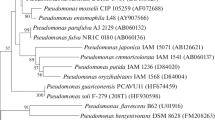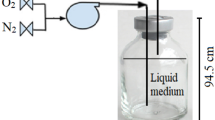Summary
A 2,4-dichlorophenoxyacetic acid (2,4-D)-degrading bacterial strain, Xanthobacter sp. CP, was isolated after enrichment in aerated soil columns. A limited number of chlorinated phenols and chlorinated phenoxyalkanoic acids with an even number of carbon atoms in the side chain served as substrates for growth, although whole cells exhibited oxygen uptake with a wide range of those compounds. The maximal growth rate with 2,4-D was 0.13·h-1 at a growth yield of 0.1 g biomass/g 2,4-D. Chloride ions were released quantitatively from 2,4-D and related chlorinated aromatic compounds which served as growth substrates. No by-products of 2,4-D metabolism were detected in oxygen-sufficient cultures of Xanthobacter sp. CP and catechols were cleaved exclusively by catechol 1,2-dioxygenase.
Similar content being viewed by others
References
Bartels I, Knackmuss H-J, Reineke W (1984) Suicide inactivation of catechol 2,3-dioxygenase from Pseudomonas putida mt-2 by 3-halocatechols. Appl Environ Microbiol 47(3):500–505
Beadle CA, Smith ARW (1982) The purification and properties of 2,4-dichlorophenol hydroxylase from a strain of Acinetobacter species. Eur J Biochem 123:323–332
Bollag J-M, Helling CS, Alexander M (1968) 2,4-D metabolism: enzymatic hydroxylation of chlorinated phenols. J Agric Food Chem 16:826–828
Bradford MM (1976) A rapid and sensitive method for the quantitation of microgram quantities of protein utilizing the principle of protein-dye binding. anal Biochem 72:248–254
Dorn E, Knackmuss H-J (1978a) Chemical structure and biodegradability of halogenated aromatic compounds. Biochem J 174:73–84
Dorn E, Knackmuss H-J (1978b) Chemical structure and biodegradability of halogenated aromatic compounds. Biochem J 174:85–94
Evans WC, Smith BSW, Fernley HN, Davies JI (1971) Bacterial metabolism of 2,4-dichlorophenoxyacetate. Biochem J 122:543–551
Gibson DT (1971) Assay of enzymes of the aromatic metabolism. In: Norris JR, Ribbons DW (eds) Methods in Microbiology 6A, Academic Press, London pp 463–478
Helling CS, Bollag J-M, Dawson JE (1968) Cleavage of the ether-oxygen bond in phenoxyacetic acid by an Arthrobacter sp. J Agric Food Chem 16(3):538–539
Liu T, Chapman PJ (1984) Purification and properties of a plasmid-encoded 2,4-dichlorophenol hydroxylase. FEBS Lett 173:314–318
Müller R, Haug S, Eberspächer J, Lingens F (1977) Catechol-2,3-dioxygenase aus Pyrazon-abbauenden Bakterien. Hoppe Seyler's Z Physiol Chem 358:787–805
Palleroni NJ (1984) Family I. Pseudomonaceae. In: Bergey's manual of systematic bacteriology, part 1, 1st edn, Williams and Wilkins, Baltimore, pp 141–290
Pieper DH, Reineke W, Engesser K-H, Knackmuss H-J (1988) Metabolism of 2,4-dichlorophenoxyacetic acid, 4-chloro-2-methylphenoxyacetic acid and 2-methylphenoxyacetic acid by Alcaligenes eutrophus JMP 134. Arch Microbiol 150:95–102
Schwien U, Schmidt E (1982) Improved degradation of monochlorophenols by a constructed strain. Appl Environ Microbiol 44:3–39
Shaler TA, Klečka GM (1986) Effects of dissolved oxygen concentration on biodegradation of 2,4-dichlorophenoxyacetic acid. Appl Environ Microbiol 51(5):950–955
Sinton GL, Fan LT, Erickson LE, Lee SM (1986) Biodegradation of 2,4-D and related compounds. Enzyme Microb Technol 8:395–403
Tiedje JM, Duxbury JM, Alexander M, Dawson JE (1969) 2,4-D metabolism: pathway of degradation of chlorocatechols by Arthrobacter sp. J Agric Food Chem 17(5):1021–1026
Tyler JE, Finn RK (1974) Growth rates of a pseudomonad on 2,4-dichlorophenoxyacetic acid and 2,4-dichlorophenol. Appl Microbiol 28(2):181–184
Wiegel JKW, Schlegel HG (1984) The genus Xanthobacter. In: Bergey's manual of systematic bacteriology, part 1, 1st edn. Williams and Wilkins, Baltimore, pp 331–333
Author information
Authors and Affiliations
Rights and permissions
About this article
Cite this article
Ditzelmüller, G., Loidl, M. & Streichsbier, F. Isolation and characterization of a 2,4-dichlorophenoxyacetic acid-degrading soil bacterium. Appl Microbiol Biotechnol 31, 93–96 (1989). https://doi.org/10.1007/BF00252535
Received:
Accepted:
Issue Date:
DOI: https://doi.org/10.1007/BF00252535




